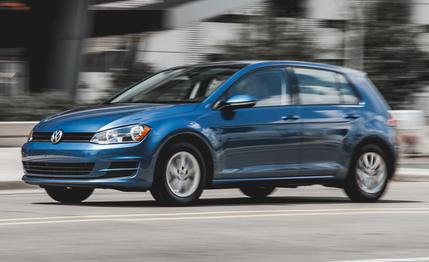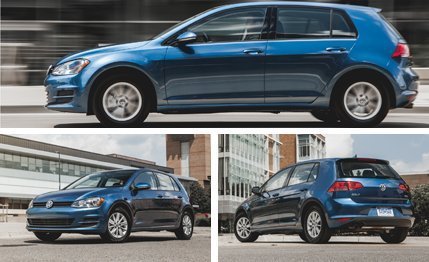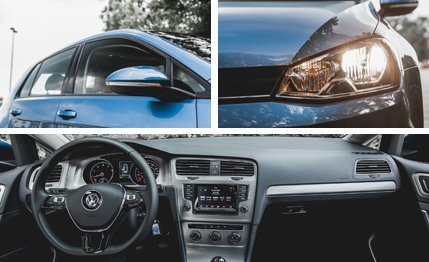
 Instrumented Test
Instrumented Test
It’s odd for us to call out the manual transmission as our primary issue with a car—we are the Save the Manuals people, after all—but that’s the case here. To be clear, our grumbling isn’t really aimed at the gearbox or the clutch, which are light and precise and rewarding to use, but rather VW’s product planning for its American Golf lineup.
The gasoline-fired TSI version of the all-new Golf is available with a stick shift only in its most basic guise. You can have a manual in any TDI diesel model, but if you want such a gearbox with a gas engine and, say, navigation, heated seats, wheels larger than 15 inches, a backup camera, auto headlamps, or push-button starting, you’re going to have to step up at least one trim grade and probably two—and that means you’ll be restricted to a six-speed torque-converter automatic. Adding a paper-cut to this hangnail, the manual transmission in the TSI employs only five forward ratios versus the TDI’s six. But, hey, the sunroof comes standard on the five-door.


The dearth of convenience features, though, helped this Golf S TSI tip the scales at less than 3000 pounds. Light and lithe, our Golf was as chuckable and tossable as any of its brethren, and it exhibited little to no understeer as it sliced up apexes and registered 0.85 g on the skidpad. (A respectable number, especially considering the modest 195/65 Continentals.) It’s also as easy to live with every day as any Golf, creature comforts notwithstanding. Credit the extrastiff chassis, the light and lively steering, and the car’s massive refinement, which is such that it wouldn’t be surprising to find four rings or a three-pointed star on the snout. Yes, even in this trim.
There’s another bonus to this stick-shift car: quickness. The manual TSI is 0.9-second quicker to 60 mph than the TSI automatic, a full second quicker than the dual-clutch-auto TDI diesel, and 1.5-seconds quicker than the manual diesel. The availability of full torque low in the rev range makes the car feel sprightlier still, even if the engine never feels as if it’s particularly thrilled about its job when asked to rev hard. Let’s call that a Germanic demeanor.


Despite our floorboard-denting driving style, this manual TSI still returned 27 mpg over 450 miles or so of mixed city and highway use. In the diesel, which costs at least $1000 more, we achieved 32 mpg with the stick and 34 with the DSG. An extra mpg or two might be within reach on gasoline, if only the 1.8 were able to spin a sixth gear; fitting a five-speed in this day and age isn’t a mortal sin, but a car that feels so premium in nearly every other way ought to have a fully modern manual transmission. At least we get the larger engine; unless they go GTI or R, German buyers can’t order a gas powerplant burlier than a 150-hp, 1.4-liter turbo four. (Wait, that engine can be had with a six-speed stick? Re-commence grumbling.)
As mentioned, this Golf S was a basic car. It sported black V-Tex vinyl upholstery—which looks and feels fine—and zero options. In fact, there is just one available option, a Lighting pack that brings bixenons with active swiveling, ambient LED interior lighting, footwell lighting, and LED daytime running lamps. Said bundle costs $995 and is far from necessary, but it does ensure that the car’s aesthetic is as polished and crisp at night as it is when the sun’s up.
And that’s really the thing. The latest Golf is a phenomenal car—full stop. We just wish this particular drivetrain were available in more fully equipped models.